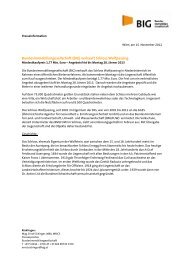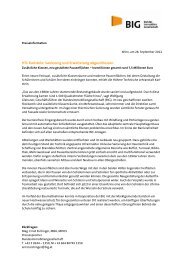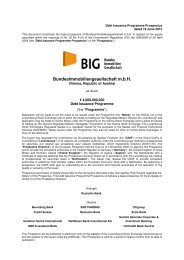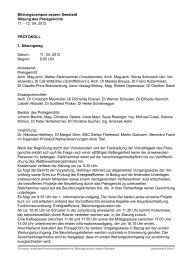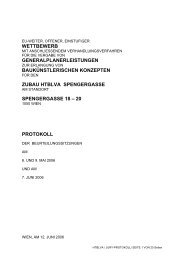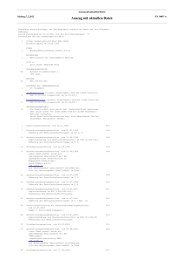Bundesimmobiliengesellschaft m.b.h. - BIG
Bundesimmobiliengesellschaft m.b.h. - BIG
Bundesimmobiliengesellschaft m.b.h. - BIG
Create successful ePaper yourself
Turn your PDF publications into a flip-book with our unique Google optimized e-Paper software.
This Analysis provides a discussion of the factors underpinning the<br />
credit rating/s and should be read in conjunction with our Credit<br />
Opinion. The most recent ratings, opinion, and other research specific<br />
to this issuer are provided on Moodys.com. Click here to link.<br />
<strong>Bundesimmobiliengesellschaft</strong> m.b.H.<br />
Analysis<br />
The Aaa rating and stable outlook of <strong>Bundesimmobiliengesellschaft</strong> mbH (<strong>BIG</strong>) reflect the company’s 100% ownership<br />
by the Republic of Austria (rated Aaa), the strategic importance of the services provided and its financial ties to the<br />
State. High dependence, as identified under the Joint Default Analysis (JDA) methodology, reflects the strong link to<br />
government departments. The main source of <strong>BIG</strong>’s revenues stems from rental income of buildings rented out to<br />
various government departments. Moreover, the state generally determines policy (tasks and obligations) of the entity,<br />
while taking financial stability into account.<br />
High support reflects the 100% ownership and no intention to privatise the company in the foreseeable future.<br />
The business model is heavily based on government-related revenues. Furthermore, the activities cannot be separated<br />
from government policy. The strong interest of the state also manifests itself in strong oversight and the ability to<br />
nominate senior management.<br />
Moreover, Moody’s JDA methodology, arrives at a baseline assessment for the company of 1 on a scale of 1-6,<br />
underpinned by the legal framework and 100% ownership by the Austrian State, even though stand-alone financials<br />
are less sound than those of a comparable private sector entity. The current opinion provides a discussion of the<br />
application of the JDA methodology.<br />
Business Franchise<br />
BACKGROUND<br />
<strong>BIG</strong> has responsibility for managing the Austrian Republic’s real estate, with a portfolio dominated by schools and<br />
universities (71%) and other administrative buildings (27%). <strong>BIG</strong>'s activities involve renting out the buildings to the<br />
various government entities, carrying out renovations and new investments and handling possible sales of redundant<br />
buildings 1 and land. <strong>BIG</strong>'s holdings include a small housing portfolio, comprising mainly the current and former<br />
homes of civil servants and other public sector employees. Finally, <strong>BIG</strong> offers facilities management services if required<br />
by the tenants. <strong>BIG</strong> consists of a holding company, <strong>Bundesimmobiliengesellschaft</strong> mbH (<strong>BIG</strong>) and three main subsidiaries<br />
– <strong>BIG</strong> Services, <strong>BIG</strong> Bauträger und Maklergesellschaft mbH and <strong>BIG</strong> Liegenschaftsverwertungsgesellschaft<br />
mbH – 100% owned by <strong>BIG</strong> and consolidated into <strong>BIG</strong>'s accounts. Moreover, the group consolidates an array of<br />
companies related to particular buildings and projects. This report focuses on the consolidated accounts.<br />
1. During 2004 <strong>BIG</strong> sold non-core assets, predominantly flats, for around €145 million.<br />
Contact Phone<br />
AUSTRIA<br />
Europe/M.East/Africa<br />
December 2005<br />
London<br />
Gabriele Baur +44 20 7772-5454<br />
Benjamin Clay<br />
New York<br />
Yves Lemay +1 212 553-1653
RAISON D’ETRE IS TO IMPROVE EFFICIENCY<br />
<strong>BIG</strong> was created by law in 1992 with the objective of centralising property management of the public sector, making it<br />
more efficient and, more importantly, trying to make the various departments more cost-conscious. The underlying<br />
premise is that, if departments are obliged to pay and account for their usage of buildings, space will only be used if<br />
really needed. This should in theory allow surplus stock to be put to alternative use or sold off.<br />
<strong>BIG</strong> BECAME OWNER OF STATE PROPERTIES STARTING IN 2001<br />
Following a revision of the act regulating <strong>BIG</strong>’s activities in 2000, the entity now owns the properties previously leased<br />
from the state. The purchase price was set at €2.4 billion, with the transfer being completed during 2003. The<br />
purchase was financed with debt.<br />
PRICE FOR TRANSFERRED ASSETS IS DEEMED FAIR<br />
Moody’s views €2.4 billion as a fair price for the transferred assets. According to an independent valuation of the<br />
properties by the Technische Universität Wien (Technical University of Vienna), the market value is €6.9 billion. The<br />
lower transfer value takes into account the specialist nature of the properties – i.e. they possibly have a lower re-sale<br />
value – and future investment needs. Moreover, if <strong>BIG</strong> sells any of the transferred assets with a positive margin over<br />
the purchase price, the entity has to pay a share of the gain to the state, i.e. a formulaic calculation of the share, taking<br />
into account the gain on disposal. The agreement with the State was revised as of 1.01.05, allowing <strong>BIG</strong> to offset some<br />
costs prior to paying out around 80% of the gain.<br />
STATE OWNERSHIP STRONGLY SUPPORTS RATING<br />
The 100% ownership of <strong>BIG</strong> by the Republic of Austria provides comfort that the owner will:<br />
• Support the entity in the event of a problem arising<br />
• Remain the main tenant of <strong>BIG</strong>, and hence provide revenue/margin stability<br />
• Determine policy (tasks and obligations) of the entity going forward, while taking financial stability into account<br />
• Supervise and control the activities of <strong>BIG</strong><br />
The State’s ownership could only be reduced below 100% through a change in the law pertaining to the <strong>Bundesimmobiliengesellschaft</strong>.<br />
Although this is not impossible, to date the Austrian State has not signalled any intention of<br />
effecting such a change, as <strong>BIG</strong> is regarded as a vital instrument in the management of the State's properties. <strong>BIG</strong>’s<br />
accounts are audited by the Federal Audit Office.<br />
Furthermore, there are no plans to extend the entity's activities to the private sector to a material degree.<br />
Although the law in question allows for <strong>BIG</strong> to carry out commercial property marketing and development, such<br />
activities are supposed to be of a subsidiary nature and there are currently no plans to expand commercial activities<br />
beyond asset sales of surplus or unused properties and land. In fact, new management reiterated in 2005 that activities<br />
will remain focused on the State, either in terms of new projects or further State asset purchases. Only a small amount<br />
will be the development of projects for third parties. In that connection, <strong>BIG</strong> envisages more projects that link State<br />
activity/policy with the private sector, like the ICT (a technology park) in Tyrol, where the university will share a<br />
building with private enterprises.<br />
2 Moody’s Analysis
Financial Fundamentals<br />
2004 RESULTS IN LINE WITH BUDGET OBJECTIVES<br />
The 2004 operating result was very much in line with the budgeted result (at €232 million compared to the budgeted<br />
€236.5 million). Pre-tax profit was almost double the budget amount at €91 million due to a considerably lower than<br />
planned interest expense. Year-on-year, the operating result was lower by 8.7%, as sales of investment assets were<br />
sizably lower than in the previous year. On the positive side, financial expense was lower than in 2003, but could not<br />
prevent a decline in pre-tax profit of 12.6%. This meant that the pre-tax profit margin fell to 12.8% in 2004 from<br />
14.1% in 2003. As mentioned before, this development was expected and <strong>BIG</strong>, by its nature and according to its policy<br />
objective, is not a profit-maximiser.<br />
RENTAL INCOME AND OCCUPANCY<br />
Rental income is the mainstay of <strong>BIG</strong>'s income, representing more than 82% of total operating revenues (excluding<br />
capital gains). Of this, 95% comprises rents received from the State – i.e. from various ministries that use the buildings.<br />
Having said this, the universities now pay <strong>BIG</strong> directly as they receive annual budgets with which they have to operate,<br />
including paying rental to <strong>BIG</strong>. As such, the universities have become the direct payers although the funds still stem<br />
from the Ministry of Education. Hence directly and indirectly, the Federal Ministry for Education accounts for the<br />
majority (71%) of <strong>BIG</strong>'s rental income in the form of schools and universities, followed by other Federal Tenants (27%)<br />
and other Tenants (2%). Rents are paid monthly or quarterly for all properties, whereas housing rents are paid monthly.<br />
Figure I: 2004 Breakdown of Rental Income by Type of Building<br />
Other Federal<br />
State<br />
27%<br />
Universities<br />
31%<br />
Schools<br />
40%<br />
There are options for giving notice under the rental agreements; the notice period is one year for tenants,<br />
covering 70% of the total revenue. However, the tenants are deemed to be relatively stable, since the ministries need<br />
the properties as a base from which to provide services such as education. The notice periods for new projects or major<br />
renovations benefit from a clause that forbids the tenant from giving notice during the debt amortisation period<br />
(usually 20-25 years).<br />
RENT LEVELS TAKE INTO ACCOUNT A REASONABLE MARGIN AND THE NEED FOR INVESTMENT<br />
Rents have been fixed on a “market” basis, while taking into account the relatively specialised nature of the properties,<br />
and as of 2003 indexed to a designated consumer price index with a one-year lag (currently CPI 1996). Adjustments are<br />
only allowed if they are 5% above this index, and the adjustment will then be in full. As such, the potential for rental<br />
increases is not considered to be particularly flexible. The first rent-adjustment under this ruling will take place in 2006<br />
as reflected in the strong increase in the rental revenue forecast for that year. During 2004, rental income was down by<br />
1%, the first decline since the inception of the rental income following the transfer/purchase of assets. The small<br />
decline is explained by the gradual sell-off of non-core rental properties.<br />
Other<br />
2%<br />
Moody’s Analysis 3
COST KEPT UNDER CONTROL<br />
<strong>BIG</strong>’s management is focused on cost efficiency, and has been successful in keeping operating costs at an acceptable<br />
level. We expect the prudent cost management to continue. Some savings have taken place due to reductions in<br />
personnel costs, in connection with restructuring of the companies. However, 2004 costs (both personnel and goods<br />
and services) were still above budget, although lower than in 2003. Maintenance costs in particular are lower as there is<br />
a reduced need for them compared to earlier years. On the other hand, personnel costs have gone up. Fortunately, the<br />
direct personnel costs of <strong>BIG</strong> are small in terms of total operating costs (4.4%). Hence the blocks on external services<br />
and maintenance are more sizeable, and hence cost control is of more importance to the bottom line.<br />
The other main item is interest expense. This is less flexible as it relates to the relatively “inflexible” debt stock<br />
accumulated to fund the previous asset purchases and future investment needs. On the positive side, future investment<br />
needs are expected to be moderate.<br />
RESULTS ARE LIKELY TO REMAIN POSITIVE ALBEIT LOWER THAN IN 2004<br />
Total consolidated pre-tax results in future years are expected to remain positive but lower than in 2004, given that<br />
financial expenditure is projected to grow at an average annual rate of 7% during the period to 2010. Some savings are<br />
expected from lower maintenance and services’ costs. On the other hand, growth in rental income is expected at a<br />
modest rate of 2.8% over the next six years, despite the hike in 2006 as a consequence of the first rental adjustment<br />
under the rent-adjustment mechanism. Other income – including that arising from service contracts and the disposal<br />
of properties – is expected to continue to represent around 10% of total operating revenues.<br />
DEBT GROWTH EXPECTED TO MODERATE<br />
<strong>BIG</strong>'s stock of debt has risen relatively rapidly since 2000 as a result of the entity having taken over properties from the<br />
central government. Based on <strong>BIG</strong>'s long-term budgets, debt is not expected to grow considerably as the bulk of the<br />
assets from the state have been purchased. Some additional minor purchases are planned during the forecast period to<br />
2010 as well as some project investments; however, growth in debt is expected to be moderate at 1.9% a year with a<br />
forecast stock of financial debt at year-end 2010 of €3.8 billion.<br />
Maturity profile shows two sets of peaks, one in 2007 and 2008 and another in 2012 and 2013, the rest is reasonably<br />
stable. Maturing issues tend to get refinanced and are generally well absorbed in the market as a consequence of<br />
the closeness of the issuer to the State. Around 88% of the total debt is euro-denominated, with the balance in Swiss<br />
francs. Interest rate stability is afforded by the fact that over 75% of the total stock is in fixed rates. <strong>BIG</strong> makes use of<br />
financial derivatives in order to hedge interest and currency exposures. The entity has acceptable prudent counterparty<br />
guidelines in place.<br />
€m<br />
OVERALL ADEQUATE LIQUIDITY PROFILE<br />
<strong>BIG</strong>’s cash flows are predictable – i.e. 90% of the rental income (the mainstay of <strong>BIG</strong>’s income) comes from the State and<br />
is paid quarterly. Cash outflows, mostly project financing and debt servicing, are also predictable. Mismatches are funded<br />
via <strong>BIG</strong>’s Euro Commercial Programme (rated P-1) of €1 billion. The average amount outstanding in 2005 amounted to<br />
around €66 million. In addition to this, <strong>BIG</strong> uses short-term drawing rights with banks. No back-up facilities are in<br />
place, yet the predictable nature of <strong>BIG</strong>'s cash-flows and its closeness to the Austrian government are mitigating factors.<br />
4 Moody’s Analysis<br />
4000<br />
3500<br />
3000<br />
2500<br />
2000<br />
1500<br />
1000<br />
500<br />
0<br />
2001<br />
2002<br />
Figure II: Debt Developments<br />
2003<br />
2004<br />
2005Budget<br />
2006Projection<br />
2007Projection<br />
2008Projection<br />
2009Projection<br />
2010Projection
Related Research<br />
Analyses:<br />
Autobahnen-Und Schnellstrassen Finanzierungs AG, November 2005 (95349)<br />
Austria, August 2005 (94100)<br />
To access any of these reports, click on the entry above. Note that these references are current as of the date of publication of this report<br />
and that more recent reports may be available. All research may not be available to all clients.<br />
Moody’s Analysis 5
<strong>Bundesimmobiliengesellschaft</strong> m.b.H. (Consolidated)<br />
Financial Statistics 2000 2001 2002 2003 2004<br />
Profit and Loss<br />
Turnover 291,101 674,468 691,573 676,825 687,807<br />
Asset Sales 0 0 0 0 0<br />
Liquidation of Reserves 0 0 0 0 0<br />
Other 156 7,881 6,088 50,656 22,502<br />
Operating Revenues (EUR 000's) 291,257 682,349 697,661 727,481 710,309<br />
Materials, Building and Services 70,465 211,698 281,442 286,766 259,684<br />
Personnel 3,142 12,294 13,366 16,241 20,099<br />
Depreciation 64,918 118,871 150,100 164,715 178,086<br />
Other 69,675 21,415 17,888 20,551 20,265<br />
Operating Costs 208,200 364,278 462,797 488,273 478,134<br />
Operating Profit 83,058 318,071 234,865 239,208 232,175<br />
Securities Income 565 354 366 44 50<br />
Interest Receiveable 1,826 2,605 5,654 11,553 2,979<br />
Other Income 0 0 1,116 0 0<br />
Interest Expenses 69,663 119,955 135,510 146,692 144,189<br />
Depreciation 7 1 1 0 0<br />
Extraordinary Charges 0 11,142 0 0 0<br />
Pre-tax Profits 15,779 189,931 106,491 104,113 91,016<br />
Income Tax 403 47,833 45,970 45,514 44,703<br />
Profit for the year (Before Allocations To and From Reserves)<br />
Balance Sheet<br />
15,377 142,098 60,521 58,599 46,313<br />
Intangible Fixed Assets 333,269 312,563 248,284 17,715 16,751<br />
Tangible Fixed Assets 1,638,215 2,500,303 3,360,484 3,996,698 4,001,829<br />
Financial Assets 4,921 4,727 5,723 11,527 24,082<br />
Fixed Assets 1,976,404 2,817,593 3,614,492 4,025,940 4,042,661<br />
Stock 37,437 47,491 14,643 11,629 5,932<br />
Debtors 44,814 76,118 95,959 95,309 92,455<br />
Securities 0 0 0 0 0<br />
Cash 3,502 40 3,675 18 79<br />
Accruals and Deferrals 4,123 4,221 5,713 12,411 10,250<br />
Current Assets 89,876 127,870 119,990 119,367 108,716<br />
Total Assets 2,066,280 2,945,462 3,734,482 4,145,307 4,151,377<br />
Short-Term Debt 327,602 404,602 0 0 0<br />
Equity 257,923 355,798 323,161 322,017 395,418<br />
Untaxed Reserves 87,850 73,177 66,334 63,747 9,126<br />
Provisions 14,374 67,842 73,582 47,781 59,910<br />
Creditors 1,344,963 2,418,149 3,237,960 3,679,595 3,652,976<br />
Accruals and Deferrals 24,025 21,011 23,103 19,250 16,185<br />
Other 9,543 9,485 10,342 12,916 17,761<br />
Total Liabilities<br />
Ratios and Analysis<br />
2,066,280 3,350,064 3,734,482 4,145,307 4,151,377<br />
Operating Margin (op. Surplus / turnover) (%) 28.53% 47.16% 33.96% 35.34% 33.76%<br />
Interest Cover (Operating Surplus / Interest Payable) (x) 1.19 2.65 1.73 1.63 1.61<br />
Operating Surplus / Total Debt (%) 5.57% 13.15% 7.25% 6.50% 6.36%<br />
Total Assets / LT Debt (x) 1.39 1.22 1.15 1.13 1.14<br />
Gearing (Debt / Equity) (x) 5.78 6.80 10.02 11.43 9.24<br />
EBITDA 150,366 439,900 392,102 415,520 413,291<br />
EBITDA / Turnover (%) 51.65% 65.22% 56.70% 61.39% 60.09%<br />
EBITDA/Interest Expenses (x) 2.16 3.67 2.89 2.83 2.87<br />
6 Moody’s Analysis
PAGE INTENTIONALLY LEFT BLANK
Rating History Bonds<br />
<br />
<br />
<br />
<br />
<br />
To order reprints of this report (100 copies minimum), please call 1.212.553.1658.<br />
Report Number: 95838<br />
Author Editor Senior Associate Senior Production Associate<br />
Gabriele Baur Maya Penrose Edina Zichy Kerstin Thoma<br />
© Copyright 2005, Moody’s Investors Service, Inc. and/or its licensors including Moody’s Assurance Company, Inc. (together, “MOODY’S”). All rights reserved. ALL INFORMATION<br />
CONTAINED HEREIN IS PROTECTED BY COPYRIGHT LAW AND NONE OF SUCH INFORMATION MAY BE COPIED OR OTHERWISE REPRODUCED, REPACKAGED, FURTHER<br />
TRANSMITTED, TRANSFERRED, DISSEMINATED, REDISTRIBUTED OR RESOLD, OR STORED FOR SUBSEQUENT USE FOR ANY SUCH PURPOSE, IN WHOLE OR IN PART, IN ANY<br />
FORM OR MANNER OR BY ANY MEANS WHATSOEVER, BY ANY PERSON WITHOUT MOODY’S PRIOR WRITTEN CONSENT. All information contained herein is obtained by<br />
MOODY’S from sources believed by it to be accurate and reliable. Because of the possibility of human or mechanical error as well as other factors, however, such information is provided “as<br />
is” without warranty of any kind and MOODY’S, in particular, makes no representation or warranty, express or implied, as to the accuracy, timeliness, completeness, merchantability or fitness<br />
for any particular purpose of any such information. Under no circumstances shall MOODY’S have any liability to any person or entity for (a) any loss or damage in whole or in part caused by,<br />
resulting from, or relating to, any error (negligent or otherwise) or other circumstance or contingency within or outside the control of MOODY’S or any of its directors, officers, employees or<br />
agents in connection with the procurement, collection, compilation, analysis, interpretation, communication, publication or delivery of any such information, or (b) any direct, indirect,<br />
special, consequential, compensatory or incidental damages whatsoever (including without limitation, lost profits), even if MOODY’S is advised in advance of the possibility of such<br />
damages, resulting from the use of or inability to use, any such information. The credit ratings and financial reporting analysis observations, if any, constituting part of the information<br />
contained herein are, and must be construed solely as, statements of opinion and not statements of fact or recommendations to purchase, sell or hold any securities. NO WARRANTY,<br />
EXPRESS OR IMPLIED, AS TO THE ACCURACY, TIMELINESS, COMPLETENESS, MERCHANTABILITY OR FITNESS FOR ANY PARTICULAR PURPOSE OF ANY SUCH RATING OR OTHER<br />
OPINION OR INFORMATION IS GIVEN OR MADE BY MOODY’S IN ANY FORM OR MANNER WHATSOEVER. Each rating or other opinion must be weighed solely as one factor in any<br />
investment decision made by or on behalf of any user of the information contained herein, and each such user must accordingly make its own study and evaluation of each security and of<br />
each issuer and guarantor of, and each provider of credit support for, each security that it may consider purchasing, holding or selling.<br />
MOODY’S hereby discloses that most issuers of debt securities (including corporate and municipal bonds, debentures, notes and commercial paper) and preferred stock rated by<br />
MOODY’S have, prior to assignment of any rating, agreed to pay to MOODY’S for appraisal and rating services rendered by it fees ranging from $1,500 to $2,400,000. Moody’s Corporation<br />
(MCO) and its wholly-owned credit rating agency subsidiary, Moody’s Investors Service (MIS), also maintain policies and procedures to address the independence of MIS’s ratings and rating<br />
processes. Information regarding certain affiliations that may exist between directors of MCO and rated entities, and between entities who hold ratings from MIS and have also publicly<br />
reported to the SEC an ownership interest in MCO of more than 5%, is posted annually on Moody’s website at www.moodys.com under the heading “Shareholder Relations — Corporate<br />
Governance — Director and Shareholder Affiliation Policy.”<br />
Moody’s Investors Service Pty Limited does not hold an Australian financial services licence under the Corporations Act. This credit rating opinion has been prepared without taking into<br />
account any of your objectives, financial situation or needs. You should, before acting on the opinion, consider the appropriateness of the opinion having regard to your own objectives,<br />
financial situation and needs.<br />
8 Moody’s Analysis








